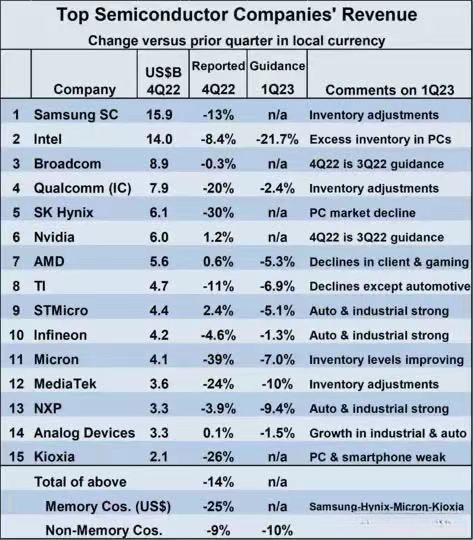The chip industry, the collective winter
The chip industry, the collective winter
"Survive" has become a key word for the entire semiconductor industry, and everyone is working together to survive this "winter".

As you can see, since the second half of last year, the economic downturn has spread to the chip sector, leading to a sharp decline in demand. Combined with geopolitical factors and other factors, the global semiconductor downward acceleration. On the one hand, chip companies have plummeted and wafer companies have adjusted their investments, while global tech companies, including semiconductor companies, have started a new wave of layoffs to save money.
Especially in China, for various well-known reasons, this unrest begins to spread between investment circles and chip start-ups, and even chip engineers feel the "chill".
Thus, "live" has become the key word of the entire semiconductor industry. We are also combining its measures to survive this "winter".
The chill spread through semiconductors
We feel the chill from the earnings results of almost all semiconductor companies and their forecasts for the future.
According to the Semiconductor Industry Association (SIA), global semiconductor industry sales in total totaled $41.3 billion in January 2023, down 5.2% from $43.6 billion in December 2022 and down 18.5% from total sales of $50.70 billion in January 2022. Among them, Chinese mainland, the global electronic equipment manufacturing center, fell a staggering 31.6% year on year.
WSWT statistics show that the recession since the end of last year continued to spread in the quarter of this year. As the chart below shows, revenue from the top 15 semiconductor suppliers fell by 14% in the fourth quarter of 2022 compared to the third quarter of 2022. The decline was memory companies, down 25%; non-memory companies down 9%. Of the 15 companies, only four (Nvidia, AMD, STMicroelectronics and Analog Devices) saw slight growth in revenue, ranging from 0.1% to 2.4%.

In the quarter of 2023, the outlook for companies was generally bleak. The semiconductor industry is usually weak in this year quarter, but most companies expect a weaker than normal 2023 quarter. From the nine non-memory companies providing quarterly revenue guidance for 2023, they all expect a decline, with a weighted average decline of 10%. Intel was the most pessimistic, with a 22 per cent drop.
It can be seen that the sales end of the recession is becoming a sticking point. To the equipment, the relevant statistics are not very ideal. Take Chinese mainland, which has the most purchasing power in recent years.
Statistics from the public account "Semiconductor Comprehensive Research" also show that in recent March, Chinese mainland semiconductor front channel manufacturing equipment import amount was $3919.5 million, down 28.8% from the same period last year. The import amount of other equipment decreased; specifically for heat treatment equipment, the total import amount of October to December was $337.8 million, down 22.9% and down 24.8%; the import amount of CVD equipment decreased by 22.3% in the same period; the import amount of PVD equipment was $205.9 million, down 43.8%; the total import amount of dry etching equipment was $719.3 million, down 26.1% and 26.1% and 34.1% in the same period.
The International Semiconductor Industry Association (SEMI) released the global Semiconductor Equipment Market forecast for 2022 in December last year also showed that while equipment sales hit a new high in 2022, the estimated 16% annual decline shrank to $91.2 billion in 2023 and returned to growth in 2024.
SEMI predicts the size of the global semiconductor equipment market (unit: US$100 million)

Under the influence of sluggish demand, the high inventory is also becoming a big problem in the industry.
Samsung Electronics lost $2.3 billion in the first two months of this year, the first loss for a South Korean giant in 15 years, South Korean media said recently. South Korean officials even said in an earlier statement that their chip stocks were up 28 percent from a month earlier. The increase since February 1996. Compared with a year ago, inventories have increased by 39.5%;
The reason why the South Korean chip will have such a tragedy, and the memory chip high-altitude diving has a great relationship. According to the latest data from Jibang Technology (TrendForce), the average selling price of DRAM for mobile phones and personal computers fell 34.4% in the previous quarter, compared from the 31.4% drop in the third quarter last year. NAND, which sees data centers and enterprise customers as the main products, performed only a little better than DRAM.
In addition to storage, chips such as MCU, power management chips, CIS, mobile phone chips and OLED driver chips are also facing inventory problems.
Under a variety of factors, the enterprise each surprise.
Companies strive to "survive"
For semiconductor companies, survival has become their goal. Layoffs became their only way of choice. Semiconductor companies including Intel, Micron, Qualcomm, Newsys, Arm, Grid Core and Lam research have all announced layoffs, according to previous incomplete statistics from semiconductor industry Watch. The wind is also known to be blowing at home.
In addition to the layoffs, chip companies are also reducing spending in various ways.
First of all, look at the wafer foundry, "price reduction" to pull customers has become another choice for them to survive the cold winter. Taiwan media recently reported also pointed out that the wafer foundry mature process bargain storm expansion, the industry, due to the capacity utilization lift as expected, united, SMC, the world advanced wafer foundry "as long as to cast, price can talk about" strategy, customers if willing to order, price discount range can reach one to twenty percent, more than previous cuts.
Taiwan media further pointed out that after the world's second largest wafer foundry south Korea samsung for the market downturn, spread cut mature process price ten percent rob sheet, now factory to fill capacity, price cuts, semiconductor into the inventory adjustment, lead to wafer foundry mature process to a buyer's market continues and continue to deteriorate.
In addition to cutting prices, cutting capital spending has become another way for wafer plant spending to counter the market downturn.
TSMC, a foundry giant, said early this year that its capital spending this year from a record high of $36.3 billion, estimated from $32 billion to $36 billion, slightly lower than market expectations, Samsung Electronics, which intends to maintain high-scale capital spending, is also expected to reduce wafer investment, highlighting the sluggish chip demand. Citigroup Global Markets, as inventory prices fall, Samsung is increasingly likely to adjust its chip supply strategy by cutting investment, UMC down 16.7% from $3.6 billion to $30, and 2023 to NT $10 billion, over NT $48%.
In the chip companies, in addition to cutting prices, destocking has become another "survival" skill.
Take MCU as an example. According to my author, consumer electronics MCU now has extremely high inventory. A number of domestic MCU practitioners revealed to the author that now everyone is devoting themselves into the bureau, to accelerate the destocking. Taiwan media news earlier is more blunt, Taiwan, China MCU manufacturer Sheng Qun confirmed that from February for distributors comprehensive cut MCU quotation. The industry believes that with the price reduction storm, many MCU manufacturers will be under pressure; as for OLED driver chips, the price of these chips, which has nearly fallen below the cost price; the cost of memory chips.
In addition to chip companies, end-customer "destocking" has also become another factor affecting the market trend. As we all know, in the past three years, the epidemic has affected supply chains, allowing many terminal manufacturers to "stock up" to cope with this uncertainty. With weak market demand, terminal manufacturers no longer place orders from chip companies. Texas Instruments, an analog chip maker, reported its fourth-quarter results earlier this year in the fourth quarter of last year. This is mainly because of customers' tendency to cut inventory. They expect the current season's demand decline to be weaker than the seasonal decline.
"Customers are doing what they have do for decades, and going on, they're building a bit of inventory. We will observe how long it will take this to resolve."Texas Instruments CFO said in an interview with the media.
Although everyone is actively destocking, but according to Taiwan, China regional Economic Daily report, a person said that the current destocking is slower than the original forecast, such as the original estimated inventory destocking speed is into 0.5 months of goods, with the sale of 1 month, can gradually reduce the inventory of 0.5 months; but now the actual situation is into 0.6 goods.
This undoubtedly brings new pressure to the inventory of chips.
The survival is for chip companies with products. But as you can see, in the past few years, there have been a lot of chip startups around the world, especially at home. For them, how to live within their means in the current environment is their fundamental. This is mainly from two dimensions: how can some chip companies that already have products invest in film, shipment, financing survival in this environment? How can a company without products control the expansion of its team size? How to raise money to survive?
The engineer's show of strength
In this wave of semiconductor decline, engineers are undoubtedly another hit group.
In the past few years, because of the influx of chip start-ups, plus the capital market, the whole chip companies have entered a state of madness, the semiconductor industry observation in the previous article also described this situation. Talent solutions company Hand (Hudson) also shows that chips saw the highest salary increase in industries in 2022, with an average increase of more than 50%.
However, in 2023, under the double blow of the capital market and the terminal market depression, everything seems to be returning to normal. First of all, we need to emphasize that what we call normal is not that the salary of chip engineers has fallen, but that chip talents are job-hopping frequently, and even the previous phenomenon of cross banks has begun to decrease.
The reason for this situation, of course, is related to the demand of enterprise talent. Foreign chip companies need not say much, freezing hiring and layoffs have been reported by many enterprises. Came to the domestic chip companies, according to the author learned, there are many chip enterprises frozen recruitment, some enterprises have even already appeared only out of the provisions, its main purpose of course is to tighten the trouser belt winter.
From some previous reports, we have also seen that some chip engineers with frequent job-hopping, their salary up, this is not alone. But in the current environment, these phenomena are not uncommon. Some engineers are in the author's communication also admitted that, in this market, to keep their job, safe winter is the first task.
However, even in the current depressed environment, HR also said that it is hard to find high-quality engineers in the market, which also shows from the side that if a chip engineer has excellent strength, they do not have to worry at any time. It also demonstrates the determination of chip companies to retain important vital forces for the next recovery.
As Malcolm Penn said in its analysis article, semiconductors will inevitably fall by 22% this year. But there's no need to panic or despair. Because past history shows that semiconductors are such a cyclical industry, and every semiconductor "crash" is actually a favorable opportunity to gain market share. For this reason Malcolm Penn suggests that it is time to roll up your sleeves and do anything necessary to survive in the short term, but he suggests that we not harm the long term.
"Any action taken now needs to be clearly and firmly bearing in mind the inevitable turnaround in 2024. This is not a time to panic, but a time to take decisive action, a cool head and first-mover advantage. It's time to prepare for the upcoming inevitable 17th industry recovery."Malcolm Penn said.